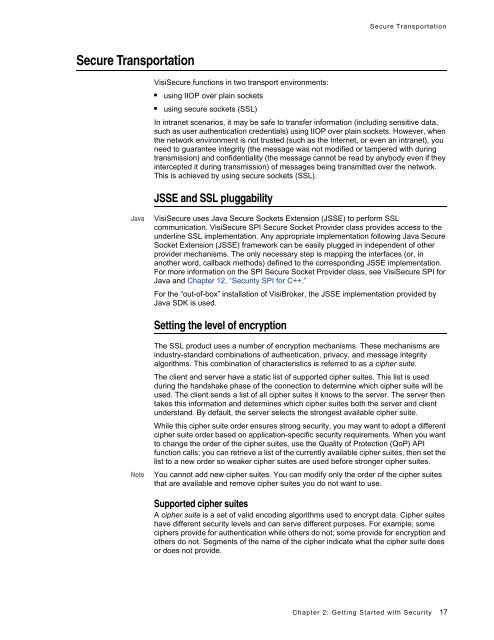Borland VisiBroker® 7.0 - Borland Technical Publications
Borland VisiBroker® 7.0 - Borland Technical Publications
Borland VisiBroker® 7.0 - Borland Technical Publications
Create successful ePaper yourself
Turn your PDF publications into a flip-book with our unique Google optimized e-Paper software.
Secure TransportationSecure TransportationVisiSecure functions in two transport environments:■using IIOP over plain sockets■using secure sockets (SSL)In intranet scenarios, it may be safe to transfer information (including sensitive data,such as user authentication credentials) using IIOP over plain sockets. However, whenthe network environment is not trusted (such as the Internet, or even an intranet), youneed to guarantee integrity (the message was not modified or tampered with duringtransmission) and confidentiality (the message cannot be read by anybody even if theyintercepted it during transmission) of messages being transmitted over the network.This is achieved by using secure sockets (SSL).JSSE and SSL pluggabilityJavaVisiSecure uses Java Secure Sockets Extension (JSSE) to perform SSLcommunication. VisiSecure SPI Secure Socket Provider class provides access to theunderline SSL implementation. Any appropriate implementation following Java SecureSocket Extension (JSSE) framework can be easily plugged in independent of otherprovider mechanisms. The only necessary step is mapping the interfaces (or, inanother word, callback methods) defined to the corresponding JSSE implementation.For more information on the SPI Secure Socket Provider class, see VisiSecure SPI forJava and Chapter 12, “Security SPI for C++.”For the “out-of-box” installation of VisiBroker, the JSSE implementation provided byJava SDK is used.Setting the level of encryptionNoteThe SSL product uses a number of encryption mechanisms. These mechanisms areindustry-standard combinations of authentication, privacy, and message integrityalgorithms. This combination of characteristics is referred to as a cipher suite.The client and server have a static list of supported cipher suites. This list is usedduring the handshake phase of the connection to determine which cipher suite will beused. The client sends a list of all cipher suites it knows to the server. The server thentakes this information and determines which cipher suites both the server and clientunderstand. By default, the server selects the strongest available cipher suite.While this cipher suite order ensures strong security, you may want to adopt a differentcipher suite order based on application-specific security requirements. When you wantto change the order of the cipher suites, use the Quality of Protection (QoP) APIfunction calls; you can retrieve a list of the currently available cipher suites, then set thelist to a new order so weaker cipher suites are used before stronger cipher suites.You cannot add new cipher suites. You can modify only the order of the cipher suitesthat are available and remove cipher suites you do not want to use.Supported cipher suitesA cipher suite is a set of valid encoding algorithms used to encrypt data. Cipher suiteshave different security levels and can serve different purposes. For example, someciphers provide for authentication while others do not; some provide for encryption andothers do not. Segments of the name of the cipher indicate what the cipher suite doesor does not provide.Chapter 2: Getting Started with Security 17







